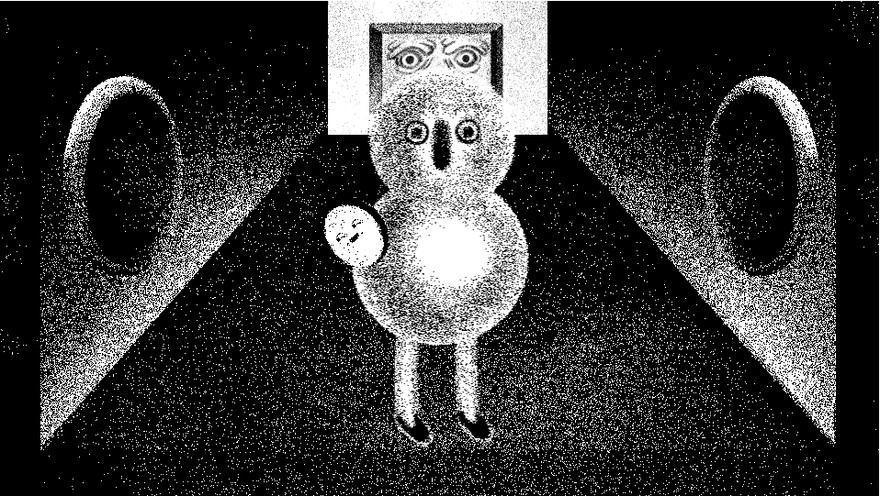While many trivialize its importance, animated cartoons have fulfilled a vital role in the human experience for as long as the medium’s been around. With worlds that mimic, exaggerate, and caricaturize our own, the animated cartoon can both satirize and uplift—often simultaneously. Hidden behind campy gestures, fantastical premises, and anthropomorphized flowers is a true reflection of our perceived realities; like a playspace that makes it safe to explore some of our most abstracted notions.
The short game Ghost Coin, by the sibling duo Konstantin (programming and design) and Elenor (art and animation) Kopka, peels back cartoonish layers to reveal something both delightful and eerie.
“The idea of a ghost world, to us, was all about this ambiguity between what’s there and what’s not,” the team says. The grayscale world comes alive with faint yet spritely ragtime music, your anthropomorphized coin avatar bouncing along to the tune. What ensues is an oddly delightful show of transmogrification, brought on by your trusty coin’s scratch-card abilities. Each character sheds a layer of film at your hand, revealing their hidden natures, emotions, insecurities.
“I love absurdity and a combination of the scary and ridiculous,” Elenor says, “its something that plays a big part in my life in general. I have always been fascinated by ghosts (in a non-esoteric way,) and the theme of a ‘world-behind-a-world.’ I try to create things that give you just enough information so you anticipate a universe behind it, while hiding the biggest part of it so you’re always left wanting to know more.”

Ghost coin certainly succeeds at this teasing game. As each successive shape comes to the forefront, your mind races to try and imagine what could possibly be uncovered. It feels almost like watching a peep show. Only, instead of unveiling a busty bosom or bottom, a peanut man disrobes down to his inner shape—which is suspiciously reminiscent of a certain Microsoft Word Paperclip.
“Surprise and discovery are basically what make the game,” Konstantin says. Which is why they spent a good portion of the game’s three day development period ensuring each and every revelation felt grotesquely enticing enough. “The game ended up being very short, but it was important to us that there would be no ‘filler’ content; that every bit would be pleasant to click.”
When I asked the duo which form they thought was each character’s “true” shape, they provided an answer which reminded me of what makes cartoons so special and culturally integral. “I think it’s less about the “true” form, and more about the coin’s way of seeing things in multiple ways—making up its own little mind about their forms.”
Of course, in cartoons, nothing is ever really “true.” Which doesn’t mean their worlds don’t often reveal the perceptions that lay dormant underneath a thin layer of our subconscious. Sure, your heart may not actually pound out of your chest whenever you see your crush. But boy, doesn’t it feel like it? Panicked and paralyzed, don’t you think everyone in the world must be able to see the inner turmoil raging inside your body in that moment?

Though Ghost Coin has no clear objective or storyline, other than just “uncover,” Konstantin speculated about his own interpretations. At the end, when the final layer you peel back to reveal “the legendary coin chest,” he says he likes to imagine “that the Ghost Coin has lost its brothers and sisters and is searching for them, overcoming the challenges of a spooky maze before finally succeeding.”
While both the siblings studied at the Academy of Visual Arts in Leipzig, Germany, Konstantin graduated over two years ago. When both felt the need to take a break from their own respective projects, they came together to create something enjoyable. Ghost Coin was the result.
To find more hidden truths behind the duo’s work, you can visit Elenor’s Tumblr and Vimeo (which features more of her awesomely uncanny animation work) and Konstantin’s website for a discography of his games, including their previous collaboration A Good Cup of Tea. Konstantin is currently working on a expanding another past named Wunderheilung.
